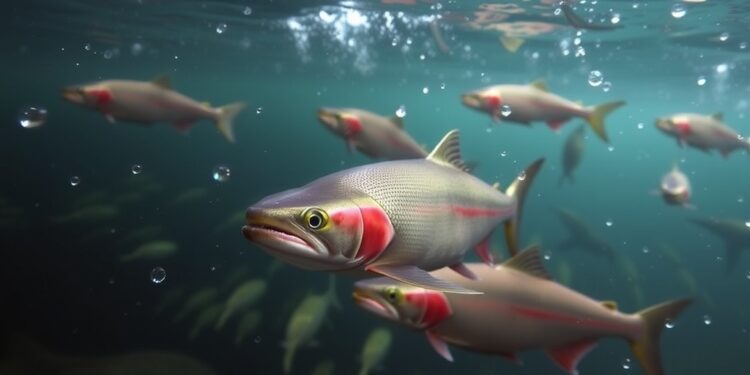Recent research has unveiled a startling connection between pharmaceutical pollution and the migration patterns of wild Atlantic salmon, drawing attention to the profound ecological ramifications associated with trace amounts of psychoactive substances in freshwater ecosystems. Clobazam, a commonly prescribed anxiolytic drug, has been shown to significantly affect the behavior of this iconic species, suggesting that the unseen chemical soup found in our waterways poses a real and present danger to aquatic life.
The study conducted by Jack Brand and his team involved a multifaceted approach combining laboratory assays with extensive field experiments to explore how clobazam impacts the physiological and behavioral traits of salmon. The presence of clobazam in the environment has long been a concern, particularly given its efficacy at minimal concentrations, allowing it to persist in natural habitats. The implications of these findings extend beyond the alarming presence of pharmaceuticals in our waterbodies; they signal a complex interplay between chemical exposure and animal behavior that could disrupt vital ecological processes.
Atlantic salmon, known for their remarkable migratory journey from freshwater rivers to the open sea, face various challenges along the way, including natural and man-made barriers such as dams. Clobazam exposure has been found to alter salmon’s navigation efficiency and decision-making processes during migration. Specifically, the research highlights that salmon smolts exposed to this anxiolytic drug exhibited increased risk-taking behavior when encountering hydropower dams, facilitating faster navigation through these critical barriers.
While the increased ability to pass through these constructed obstacles may initially seem advantageous, the researchers warn of the potential trade-offs. For instance, clobazam exposure resulted in a reduction in shoaling behavior. Shoaling is fundamental for salmon, as it provides safety in numbers against predators. The diminished cohesion among salmon groups in the presence of clobazam raises significant concerns about their vulnerability to predation during migration, possibly offsetting any short-term benefits gained from improved navigation.
The ecological consequences of these behavioral changes are profound, urging scientists and conservationists to consider the larger context of pharmaceutical pollution in freshwater environments. As contaminants continue to infiltrate waterways, the question arises: how many more species may be affected in a similar manner, experiencing altered behaviors with ripple effects throughout entire ecosystems?
Understanding these dynamics requires more than just correlational studies; it calls for a comprehensive examination of how various psychoactive substances interact with ecological systems. To this end, Brand and his colleagues have outlined future research projects aiming to delve deeper into this subject. By employing advanced tracking technologies, the team plans to follow the fine-scale movements and behavior of salmon exposed to various concentrations of clobazam and other related compounds in the wild. These high-resolution tracking tools, including miniature biologgers that can record stress levels and detect predation events, will provide invaluable insights into the extent to which pharmaceutical pollution influences predation risk and overall survival of migratory species.
Pharmaceutical pollution is not merely a localized issue; it is a global crisis affecting aquatic biomes from bustling urban centers to remote wilderness areas and even Antarctica. More than 900 pharmaceuticals and their derivatives have been identified in global water systems, a testament to the growing concern surrounding anthropogenic impacts on the environment. How these persistent pollutants interact with wildlife can pose long-term risks not just to biodiversity but also to ecosystem functionality and human health.
As the study demonstrates, even minute concentrations of medications intended for human use can disrupt fundamental survival behaviors in wildlife, amplifying the urgency for evidence-based policies aimed at mitigating these environmental threats. The ramifications of such pollution are particularly concerning for vulnerable species like the Atlantic salmon, whose migratory patterns are critical for maintaining their populations and supporting the broader ecosystem.
In conclusion, the interplay between pharmaceutical pollutants and animal behavior is a burgeoning area of research that deserves immediate attention. Brand’s study not only highlights the intricate connections between contaminants and wildlife but also serves as a clarion call for further investigation into the ecological impacts of human-made substances that infiltrate our waterways. With mounting evidence illustrating the profound effects of these substances, the time for action is now, as policymakers, conservationists, and scientists must collaborate to safeguard our aquatic environments and the species that rely on them.
The findings of this research underscore an urgent need for an integrated approach to environmental management that encompasses pollution prevention, species protection, and habitat conservation. As the world grapples with complex challenges posed by pollution, understanding and addressing the effects of pharmaceutical pollutants is critical for fostering resilient ecosystems and ensuring the sustainability of wildlife populations.
As researchers embark on this journey of discovery, the intricate dance between pharmaceutical compounds and ecological health illuminates a pressing narrative, one that calls each of us to reflect on our responsibility to protect and preserve the natural world amidst the relentless tide of environmental change.
Ultimately, the insights gleaned from this study pave the way for deeper exploration into how human activities reverberate throughout the biosphere. The challenge lies ahead in translating these findings into meaningful action that prioritizes aquatic health and biodiversity in an increasingly polluted world.
Subject of Research: Impact of pharmaceutical pollution on migration behavior in Atlantic salmon
Article Title: Pharmaceutical pollution influences river-to-sea migration in Atlantic salmon (Salmo salar)
News Publication Date: 11-Apr-2025
Web References: http://dx.doi.org/10.1126/science.adp7174
References: N/A
Image Credits: N/A
Keywords: Atlantic salmon, pharmaceutical pollution, clobazam, migration behavior, ecological consequences, freshwater ecosystems, anxiolytic drugs, human impact, biodiversity, environmental management.




